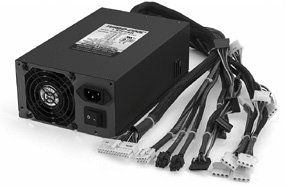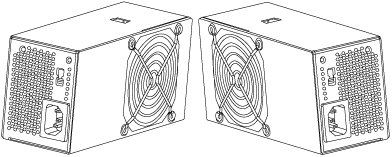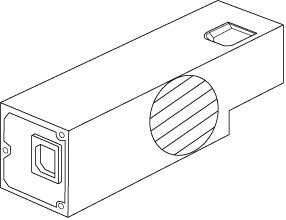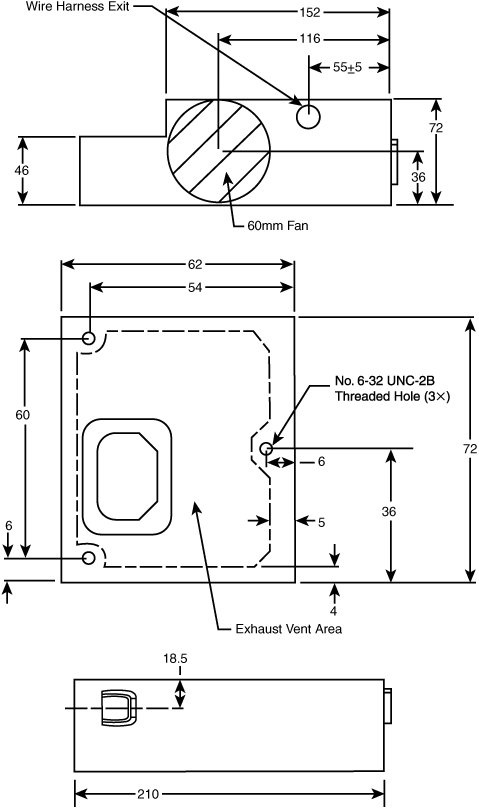Power Supply Form Factors
| The shape and general physical layout of a component is called the form factor. Items that share a form factor are generally interchangeable, at least as far as their sizes and fits are concerned. When designing a PC, the engineers can choose to use one of the popular standard power supply unit (PSU) form factors, or they can elect to build their own custom design. Choosing the former means that a virtually inexhaustible supply of inexpensive replacement parts will be available in a variety of quality and power output levels. Going the custom route means additional time and expense for development. In addition, the power supply is unique to the system and generally available for replacement only from the original manufacturer. This precludes any upgrades as well, such as installing higher-output replacement models. If you can't tell already, I am a fan of the industry-standard form factors! Having standards and then following them allows us to upgrade and repair our systems by easily replacing physically (and electrically) interchangeable components. Having interchangeable parts means that we have a better range of choices for replacement items, and the competition makes for better pricing, too. In the PC market, IBM originally defined the form factor standards and everybody else copied themand this included power supplies. All the popular PC power supply form factors up through 1995 were based on one of three IBM models, including the PC/XT, AT, and PS/2 Model 30. The interesting thing is that these three original IBM power supply form factors all had the same motherboard connectors and pinouts; where they differed was mainly in shape, maximum power output, the number of peripheral power connectors, and switch mounting. PC systems using knock-offs of one of those three designs were popular up through 1996 and beyond; in fact, even the current standard ATX12V models are based on the PS/2 Model 30 physical form factor, but with different connectors. Intel defined a new power supply form factor in 1995 with the introduction of the ATX form factor. ATX became popular in 1996 and started a shift away from the previous IBM-based standards. ATX and the standards that have followed since use different connectors with additional voltages and signals that allow systems with greater power consumption and additional features that would otherwise not be possible with the AT-style supplies. Note Although two power supplies can share the same basic design and form factor, they can differ greatly in quality and efficiency. Later in this chapter, you'll learn about some of the features and specifications to look for when evaluating PC power supplies. More than 10 different power supply form factors have existed that can be called industry standard. Many of these are or were based on designs IBM created in the 1980s, whereas the rest are based on Intel designs from the 1990s to the present. The industry-standard form factors can be broken down into two main categories: those that are currently in use in modern systems and those that are largely obsolete. Note that although the names of some of the power supply form factors seem to be the same as those of motherboard form factors, the power supply form factor relates more to the system chassis (case) than to the motherboard. That is because all the form factors use one of only two main types of connector designs: either AT or ATX, with subtle variations on each. So, although a particular power supply form factor might be typically associated with a particular motherboard form factor, many other power supplies would plug in as well. For example, all modern ATX form factor motherboards with PCI Express slots have two main power connectors, including a 24-pin ATX main connector along with a 4-pin +12V connector. All the modern power supply form factors, including ATX12V, SFX12V, EPS12V, TFX12V, CFX12V, and LFX12V, include these same connectors and therefore plug in to the same motherboard. In other words, no matter what the form factor of the motherboard (ATX, BTX, or any of the smaller variants of either), virtually any of the modern industry-standard power supplies will plug in. Plugging the power supply connectors into the motherboard is one thing, but for the power supply to work in the system, it must physically fit inside the chassis or caseand that is what the different modern power supply form factors are all about. The bottom line is that it is up to you to ensure that the power supply you purchase not only plugs in to your motherboard, but also fits into the chassis or case you plan to use. Tables 19.2 and 19.3 show the industry-standard power supply form factors, their connector types, and the motherboard form factors with which they are usually associated.
Each of these power supply form factors is, or has been, available in numerous configurations and power output levels. The obsolete LPX form factor supply originated in the IBM PS/2 Model 30 in April 1987 and was the standard used on most systems from the late 1980s to mid-1996, when the ATX form factor started to gain in popularity. Since then, ATX and variants of ATX have become by far the dominant form factors for power supplies. It is interesting to note that IBM's legacy lives on even now because ATX, PS3, and EPS are all based on the LPX (PS/2) physical form factor. Any power supply that does not conform to one of these standards is considered proprietary. Any systems that use proprietary power supply designs should generally be avoided because replacements are difficult to obtain and upgrades are generally not available. When you consider that the power supply is one of the most failure-prone components, purchasing systems that use proprietary designs can be a significant liability.
Obsolete Form FactorsThe following sections explain in detail the form and function of power supply variants that are no longer in use today. Although most users aren't likely to encounter these designs, if you support older PCs, you will. PC/XTIBM's PC and XT systems (circa 1981 and 1983, respectively) used the same power supply form factor; the only difference was that the XT supply had more than double the power output capability. Because they were identical in external appearance and the type of connectors they used, you easily could install the higher-output XT supply as an upgrade for a PC system; thus, the idea of upgrading the power supply was born. The tremendous popularity of the original PC and XT systems led several manufacturers to begin building systems that mimicked their shapes and layouts. These clones or compatibles, as they have been called, could interchange virtually all components with the IBM systems, including power supplies. Numerous manufacturers then began producing components that followed the form factors used in these systems. The PC/XT power supply and connectors are shown in Figure 19.1. This form factor, however, is considered obsolete. Figure 19.1. PC/XT form factor power supply. AT/DeskThe AT desktop system that IBM introduced in August 1984 had a larger power supply and a form factor different from the original PC/XT. Other manufacturers rapidly cloned this system, which represented the basis for many subsequent IBM-compatible designs. The power supply used in these systems was called the AT/Desktop-style power supply (see Figure 19.2). Hundreds of manufacturers began making motherboards, power supplies, cases, and other components that were physically interchangeable with the original IBM AT. This form factor is considered obsolete. Figure 19.2. AT/Desktop form factor power supply.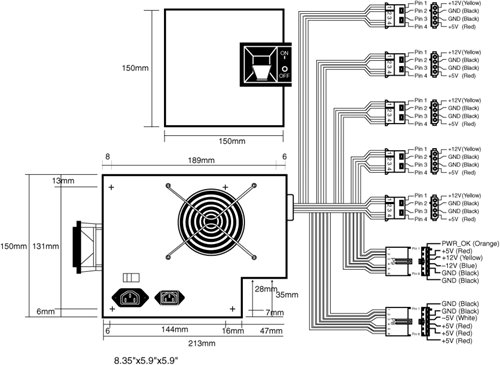 AT/TowerThe AT/Tower configuration was basically a full-sized, AT-style desktop system running on its side. The tower configuration was not new; in fact, even IBM's original AT had a specially mounted logo that could be rotated when you ran the system on its side in the tower configuration. The type of power supply used in most of the AT tower systems was identical to that used in a desktop system, except for the location of the power switch. On the original AT/Desktop systems, the power switch was built in to the side of the power supply (usually in the form of a large toggle switch). AT/Tower systems instead used an external switch attached to the power supply through a four-wire cable. A full-sized AT power supply with a remote switch is called an AT/Tower form factor power supply and is identical to the AT/Desktop supply in size and dimensions. The only difference is the use of an external switch (see Figure 19.3). This form factor is considered obsolete. Figure 19.3. AT/Tower form factor power supply.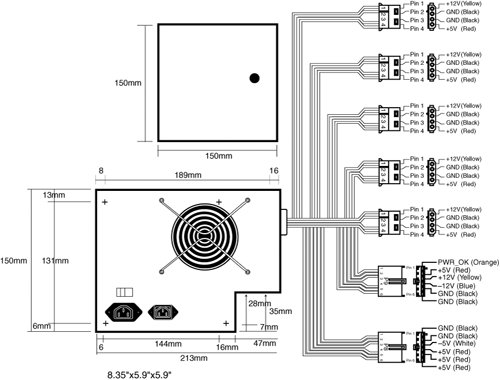 Baby-ATAnother type of AT-based form factor is the so-called Baby-AT, which is a shortened version of the full-size AT form factor. The power supply in these systems is shortened in one dimension but matches the AT design in all other respects. Baby-ATstyle power supplies could fit in place of the larger AT/Desktop-style supply; however, the full-size AT/Tower supply would not fit in the Baby-AT chassis (see Figure 19.4). Because the Baby-AT PSU performed the same functions as the AT-style power supply but was in a smaller package, it became a common form factor until it was overtaken by later designs. This form factor is considered obsolete. Figure 19.4. Baby-AT form factor power supply.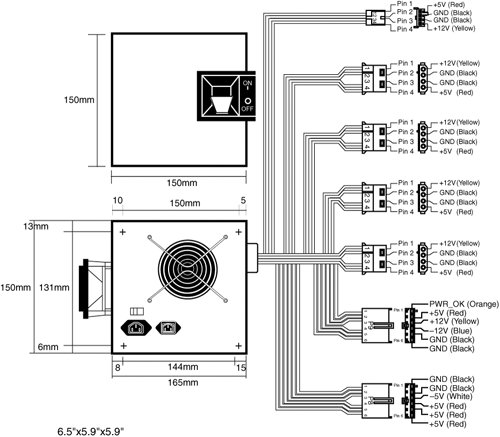 LPXThe next power supply form factor to gain popularity was the LPX style, also called the PS/2 type, Slimline, or slim style (see Figure 19.5). The PS/2 designation is in reference to the fact that this design originated in the IBM PS/2 Model 30 introduced in April 1987. The LPX-style power supply used the exact same motherboard and disk drive connectors as the previous PC/XT and AT-based standard power supply form factors. LPX power supplies were used primarily in systems with LPX, Baby-AT, or Mini-AT motherboards. Figure 19.5. LPX form factor power supply. The LPX power supply quickly found its way into many manufacturers' systems and soon became a de facto standard. This style of power supply became the staple of the industry for many years, coming in everything from low-profile systems using actual LPX motherboards to desktop or mid-tower systems with Baby-AT or Mini-AT motherboards, as well as full-size towers using Baby-AT or even full-size AT motherboards. Although considered obsolete, the LPX (PS/2) design is still sold today; however, you certainly won't find it in any new PCs. The mechanical form factor lives on, though, because it was the basis for the ATX and PS3 designs that are used in modern systems. Modern Form FactorsThe power supply form factors detailed in the following sections are the standards that continue to be implemented in current systems. ATX is far and away the most common of these, but if you work on a variety of PC types, you are likely to encounter the other types listed here. ATX/ATX12VIn 1995, Intel saw that the existing power supply designs were literally running out of power. The problem was that the existing standards used two connectors with a total of only 12 pins providing power to the motherboard. In addition, the connectors used were difficult to properly key and plugging them in improperly resulted in short-circuiting and damage to both the motherboard and the power supply. To solve these problems, in 1995 Intel took the existing popular LPX (PS/2) design and simply changed the internal circuitry and connectors (while leaving the mechanical shape the same), giving birth to the ATX power supply form factor (see Figure 19.6). Figure 19.6. ATX12V 2.x form factor power supply with 24-pin main, 4-pin +12V, and optional PCI Express Graphics connectors.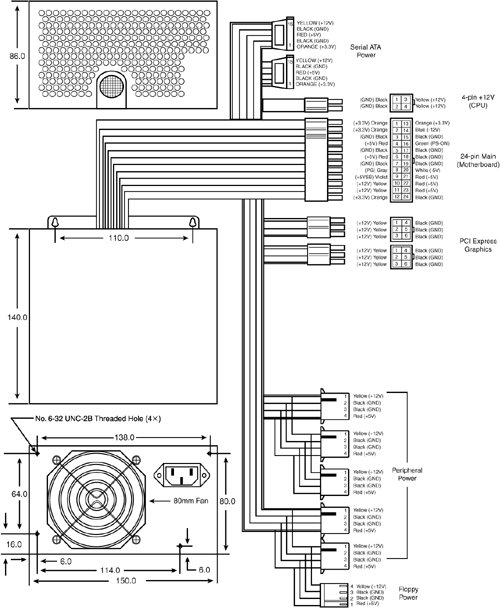 Intel first released the ATX specification in 1995 and in 1996, it started to become increasingly popular in Pentium and Pentium Probased PCs, capturing 18% of the market within the first year. Since 1996, ATX variants have become both the dominant motherboard and power supply form factors, replacing the previously popular Baby-AT/LPX designs. ATX12V power supplies are also used with newer motherboard form factors like BTX, ensuring that ATX and its derivatives will remain the most popular power supply form factors for several years to come. The ATX12V specification defines the physical or mechanical form as well as the electrical connectors for the power supply. From 1995 through early 2000, the ATX power supply form factor was defined as part of the ATX motherboard specification. However, in February 2000, Intel took the power supply specification out of the then-current ATX 2.03 motherboard/chassis specification and created the ATX/ATX12V power supply specification 1.0, adding an optional 4-pin +12V connector at the same time (those with the +12V connector were called ATX12V supplies). The +12V connector was made a requirement in version 1.3 (April 2002), whereupon the specification became only ATX12V. The ATX12V 2.0 specification (February 2003) dropped the 6-pin auxiliary connector, changed the main power connector to 24 pins, and made Serial ATA power connectors a requirement as well. The current version is ATX12V 2.2, which was released in March 2005 and contains only minor changes from the previous releases, such as the use of high current system (HCS) terminals in the connectors. As the ATX power supply specification has evolved, there have been some changes in the cooling fan orientation and design. The ATX specification originally called for an 80mm fan to be mounted along the inner side of the supply, where it could draw air in from the rear of the chassis and blow it inside across the motherboard. This kind of airflow runs in the opposite direction than most standard supplies, which exhaust air out the back of the supply through a hole in the case where the fan protrudes. The idea was that the reverse-flow design could cool the system more efficiently with only a single fan, eliminating the need for a fan (active) heatsink on the CPU. Another benefit of the reverse-flow cooling is that the system would run cleaner, freer from dust and dirt. The case would be pressurized, so air would be continuously forced out of the cracks in the casethe opposite of what happens with a negative pressure design. For this reason, the reverse-flow cooling design is often referred to as a positive-pressure-ventilation design. On an ATX system with reverse-flow cooling, the air is blown out away from the drive because the only air intake is the single fan vent on the power supply at the rear. For systems that operate in extremely harsh environments, you can add a filter to the fan intake vent to further ensure that all the air entering the system is clean and free of dust. Although this sounds like a good way to ventilate a system, the positive-pressure design needs to use a more powerful fan to pull the required amount of air through a filter and pressurize the case. Also, if a filter is used, it must be serviced on a periodic basisdepending on operating conditions, it could need changing or cleaning as often as every week. In addition, the heat load from the power supply on a fully loaded system heats the air being ingested, blowing warm air over the CPU and reducing the overall cooling capability. As CPUs evolved to generate more and more heat, the cooling capability of the system became more critical and the positive-pressure design was simply not up to the task. Therefore, subsequent versions of the ATX specification were rewritten to allow both positive- and negative-pressure designs, but they emphasized the standard negative-pressure system with an exhaust fan on the power supply and an additional high-quality cooling fan blowing cool air right on the CPU as the best solution. Because a standard negative-pressure system offers the greatest cooling capacity for a given fan's airspeed and flow, virtually all the newer ATX-style power supplies use a negative-pressure design, in which air flows out the back of the power supply. Most use an 80mm fan mounted on the rear of the unit blowing outward, but some use an 80mm, a 92mm, or a 120mm fan mounted on the inside upper or lower surface, with open vents on the rear of the system. In either example, the flow of air is such that air is always exhausted out of the system through the rear of the supply. The ATX power supply form factor addressed several problems with the previous PC/XT, AT, and LPX-type supplies. One is that the power supplies used with PC/XT/AT boards had only two connectors that plugged in to the motherboard. If you inserted these connectors backward or out of their normal sequence, you would usually fry both the motherboard and the power supply! Most responsible system manufacturers tried to "key" the motherboard and power supply connectors so you couldn't install them backward or out of sequence. However, most vendors of cheaper systems did not feature this keying on the boards or supplies they used. The ATX form factor includes intelligently designed and keyed power plugs to prevent users from incorrectly plugging in their power supplies. The ATX connectors also supply +3.3V, reducing the need for voltage regulators on the motherboard to power +3.3V-based circuits. Besides the new +3.3V outputs, ATX power supplies furnish another set of outputs that is not typically seen on standard power supplies. The set consists of the Power_On (PS_ON) and 5V_Standby (5VSB) outputs mentioned earlier, known collectively as Soft Power. This enables features to be implemented, such as Wake on Ring or Wake on LAN, in which a signal from a modem or network adapter can actually cause a PC to wake up and power on. Many such systems also have the option of setting a wake-up time, at which the PC can automatically turn itself on to perform scheduled tasks. These signals also can enable the optional use of the keyboard to power the system onan option you can set on some systems. These features are possible because the +5V Standby power is always active, giving the motherboard a limited source of power even when off. Check your BIOS Setup for control over these types of features. SFX/SFX12VIntel released the smaller microATX motherboard form factor in December 1997, and at the same time also released the SFX (small form factor) power supply design to go with it. Even so, most microATX chassis continued to use the standard ATX power supply instead. Then in March 1999, Intel released the FlexATX addendum to the microATX specification, which was a very small board designed for low-end PCs or PC-based appliances. Since then, the SFX supply has found use in many new compact system designs. Unlike most of the power supply form factor specifications in which a single mechanical or physical outline is defined, the SFX standard actually defines five different physical shapes, some of which are not directly interchangeable. In addition, there have been changes to the connectors required as the specification has evolved. Therefore, when replacing an SFX/SFX12V-type supply, you need to ensure you are purchasing the correct typewhich is to say the type that will physically install in your chassisas well as have the correct connectors for your motherboard. The number and types of connectors have changed over the life of the specification. The original SFX power supply specification included a single 20-pin motherboard connector. The 4-pin +12V connector to provide independent CPU power was added as an option in the 2.0 revision (May 2001) and was made a requirement in revision 2.3 (April 2003), causing the spec to be renamed as SFX12V in the process. SFX12V version 3.0 changed the main motherboard power connector from 20 pins to 24 pins and made Serial ATA power connectors a requirement as well. The current SFX12V version 3.1 was released in March 2005 and contains a few additional minor revisions, including a change to HCS terminals in the connectors. SFX12V includes several physical designs, including one called the PS3 form factor. On a standard SFX/SFX12V power supply, a 60mm diameter cooling fan is located inside the power supply housing, facing the inside of the computer's case (see Figure 19.7). The fan draws the air into the power supply housing from the system cavity and expels it through a port at the rear of the system. Internalizing the fan in this way reduces system noise and results in a standard negative-pressure design. The system can also use additional processor and chassis cooling fans, which are separate from the power supply. Figure 19.7. SFX/SFX12V standard power supply with internal 60mm fan.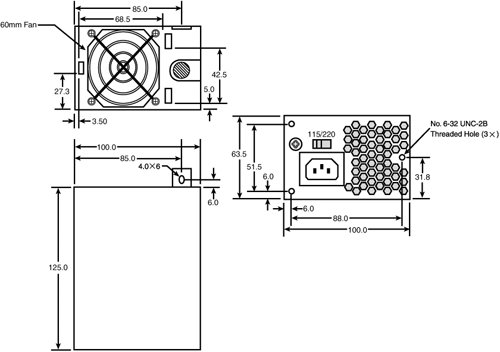 For systems that require more cooling capability, a version that allows for a larger, 80mm top-mounted cooling fan also is available. The larger fan provides more cooling capability and airflow for systems that need it (see Figure 19.8). Figure 19.8. SFX/SFX12V standard power supply with a recessed, top-mounted 80mm fan.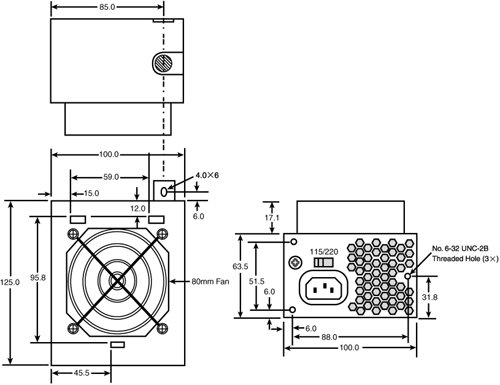 Another variation of SFX12V also uses a recessed top-mounted 80mm cooling fan, but it has the body of the power supply rotated for greater width but reduced depth, as shown in Figure 19.9. Figure 19.9. SFX/SFX12V rotated power supply with a recessed top-mounted 80mm fan.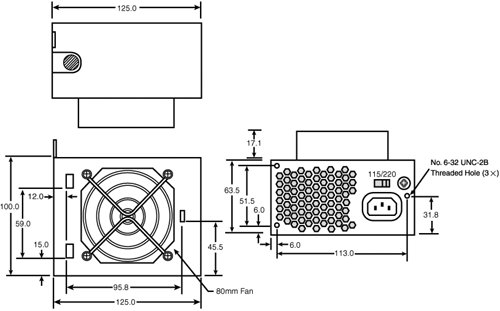 A special low-profile version of SFX12V designed for a slim chassis is only 50mm tall with an internal 40mm cooling fan, as shown in Figure 19.10. Figure 19.10. SFX/SFX12V low-profile power supply with internal 40mm fan. Finally, a more recent variation on SFX is called the PS3 form factor, defined in Appendix E of the SFX12V specification. Although defined as part of SFX12V, the PS3 form factor is actually a shortened version of ATX12V and is generally used in systems with microATX chassis and motherboards that require higher power output than the smaller SFX variants can supply (see Figure 19.11). Figure 19.11. PS3 (SFX/SFX12V) power supply with internal 80mm fan.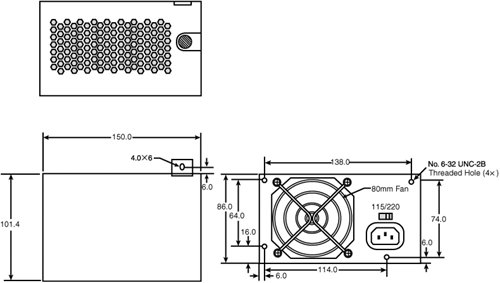 SFX12V power supplies are specifically designed for use in small systems containing a limited amount of hardware and limited upgradability. Most SFX supplies are designed to provide 80300 watts of continuous power in four voltages (+5V, +12V, 12V, and +3.3V). This amount of power has proven to be sufficient for a small system with a processor, an AGP or PCI Express x16 interface, up to four expansion slots, and three peripheral devicessuch as hard drives and CD-ROMs. Although Intel designed the SFX12V power supply specification with the microATX and FlexATX motherboard form factors in mind, SFX is a wholly separate standard that is compliant with other motherboards as well. For example, the PS3 variant of SFX12V can be used to replace standard ATX12V power supplies as long as the output capabilities and provided connectors match the system requirements. SFX power supplies use the same 20-pin or 24-pin connectors defined in the ATX/ATX12V standards and include both the Power_On and 5V_Standby outputs. SFX12V power supplies add the 4-pin +12V connector for CPU power, just as ATX12V supplies do. Whether you will use an ATX- or SFX-based power supply in a given system depends more on the case or chassis than the motherboard. Each has the same basic electrical connectors; the main difference is which type of power supply the case is physically designed to accept. EPS/EPS12VIn 1998, a group of companies including Intel, Hewlett-Packard, NEC, Dell, Data General, Micron, and Compaq created the Server System Infrastructure (SSI), an industry initiative to promote industry-standard form factors covering common server hardware elements such as chassis, power supplies, motherboards, and other components. The idea was to be able to design network servers that could use industry-standard interchangeable parts. You can find out more about SSI at www.ssiforum.org. Although this book does not cover network servers, in many ways a low-end server is a high-end PC, and many high-end components that were once found only on servers have trickled down to standard PCs. This trickle-down theory is especially true when it comes to power supplies. In 1998, the SSI created the entry-level power supply (EPS) specification, which defines an industry-standard power supply form factor for entry-level pedestal (standalone tower chassis) servers. The initial EPS standard was based on ATX, but with several enhancements. The first major enhancement was the use of a 24-pin main power connector, which eventually trickled down to the ATX12V as well as other power supply form factor specifications in 2003. EPS also originally called for the use of HCS terminals in the Molex Mini-Fit Jr.based power supply connectors, which became standard in ATX12V in March 2005 as well. In addition, both the (now-obsolete) auxiliary 6-pin power connector, the 4-pin +12V power connector, and a variation of the 6-pin graphics power connector all appeared in the EPS specifications before ending up in ATX. The EPS specification originally used a mechanical form factor identical to ATX, but the EPS form factor was later extended to support higher power outputs by allowing the body of the supply to be deeper if necessary. The ATX and the original EPS standards call for a supply that is 86mm tall by 150mm wide by 140mm deep, the same dimensions as the LPX or PS/2 form factors. EPS later added optional extended depths of 180mm and 230mm total. You may think these would require a custom EPS chassis, but in fact many (if not most) full-sized ATX tower chassis can handle these greater depths without interference, especially when using one of the newer breed of shorter-length optical drives (because one or more of the optical drives are often inline with the power supply). With the improvements in EPS/EPS12V power supplies trickling down to ATX/ATX12V, I have studied the SSI EPS specifications to see what potential improvements might come to ATX. The main difference today between ATX and EPS with respect to connectors is the use of an 8-pin dual +12V connector in EPS12V instead of a 4-pin +12V connector in ATX12V. The 8-pin dual +12V connector is essentially the equivalent of two 4-pin connectors mated together and is used by entry-level servers to power multiple processors. Because of the way the connectors are designed, an 8-pin +12V connector can plug in to a 4-pin +12V connector on a motherboard, with the unused pins simply hanging unused, offset to one side or the other. The only other major difference between EPS12V and ATX12V is that EPS power supplies can be up to 180mm or 230mm deep, while ATX supplies are technically limited to 140mm depth according to the specification. An example of an EPS12V type supply is the Turbo-Cool 1KW (1-kilowatt) model from PC Power and Cooling (see Figure 19.12). Figure 19.12. Turbo-Cool 1KW EPS12V form factor power supply (www.pcpowercooling.com). This power supply is basically a 230mm deep EPS12V supply that works in place of or as an upgrade to an ATX12V supply as long as the chassis can accommodate the additional depth. EPS12V supplies are sometimes called extended ATX power supplies because of their optional extended length. If you plan on using one of these EPS12V power supplies in a standard ATX chassis, it's important that you measure the available space in your chassis to ensure you have the room behind the supply for the additional depth. Connector compatibility isn't generally a problem because, by virtue of the Molex Mini-Fit Jr. connector design, you can plug a 24-pin main power connector into a 20-pin socket, as well as an 8-pin dual +12V connector into a 4-pin +12V socket. If you have the room, an EPS12V power supply can be used with most ATX chassis and motherboards for the ultimate in high-output capabilities. TFX12VThe TFX12V (thin form factor) power supply was originally introduced by Intel in April 2002 and is designed for small form factor (SFF) systems of about 915 liters in volume, primarily those using low-profile SFF chassis and microATX, FlexATX, or Mini-ITX motherboards. The basic shape of TFX12V is longer and narrower than the ATX- or SFX-based form factors, allowing it to more easily fit into low-profile systems. The dimensions of the TFX12V form factor are shown in Figure 19.13. Figure 19.13. TFX12V power supply form factor dimensions. TFX12V power supplies are designed to deliver nominal power output capabilities of 180300 watts, which is more than adequate for the smaller systems for which they are designed. TFX12V supplies include a side-mounted internal 80mm fan that is usually thermostatically controlled, so as to run both coolly and quietly. A symmetrically designed mounting system allows the fan to be oriented facing either side inside the system for optimum cooling and flexibility in accommodating different chassis layouts (see Figure 19.14). Figure 19.14. TFX12V power supplies are symmetrical and can be mounted with the fan facing either left or right. Unlike SFX-based supplies, only one standard mechanical form factor exists for TFX12V supplies. TFX12V supplies have also always included the 4-pin +12V connector since the standard appeared in April 2002, well after the +12V connector had been included in other power supply form factors. TFX12V 1.2 (April 2003) added the Serial ATA power connector as an option, while the TFX12V 2.0 release (February 2004) made them mandatory and changed the main power connector from 20 pins to 24 pins. Revision 2.1 (July 2005) includes only minor updates and changes from the previous version. CFX12VThe CFX12V (compact form factor) power supply was originally introduced by Intel in November 2003 and is designed for mid-sized BTX (balanced technology extended) systems of about 1015 liters in volume, primarily using microBTX or picoBTX motherboards. CFX12V power supplies are designed to deliver nominal power output capabilities of 220300 watts, which is more than adequate for the mid-sized systems for which they are designed. CFX12V supplies include a rear-mounted internal 80mm fan that is typically thermostatically controlled, so as to run both coolly and quietly. The shape of the supply includes a ledge such that part of the supply can extend over the motherboard, reducing the overall size of the system (see Figure 19.15). The dimensions of the CFX12V form factor are shown in Figure 19.16. Figure 19.15. CFX12V power supply. Figure 19.16. CFX12V power supply dimensions.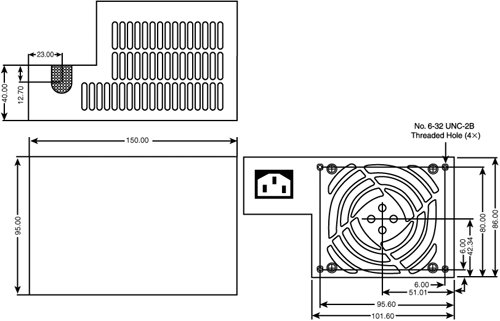 CFX12V supplies have always included the 4-pin +12V connector since the standard first appeared in November 2003, well after the +12V connector had been included in other power supply form factors. TFX12V also included the 24-pin main power connector as well as Serial ATA power connectors as mandatory since its inception. The current CFX12V 1.2 release dates from 2005 and has only minor revisions over previous versions, including a change to HCS terminals in the connectors. LFX12VIntel originally introduced the LFX12V (low profile form factor) power supply in April 2004. It's designed for ultra-small BTX systems of about 69 liters in volume, primarily using picoBTX or nanoBTX motherboards. LFX12V power supplies are designed to deliver nominal power output capabilities of 180260 watts, which is ideal for the tiny systems for which they are designed. LFX12V supplies include an internal 60mm fan, which is 20mm smaller than that of the CFX12V design. Similar to the CFX12V fan, it is usually thermostatically controlled to ensure quiet operation while still providing adequate cooling. The shape of the supply includes a ledge such that part of the supply can extend over the motherboard, reducing the overall size of the system (see Figure 19.17). The dimensions of the LFX12V form factor are shown in Figure 19.18. Figure 19.17. LFX12V power supply. Figure 19.18. LFX12V power supply dimensions. All LFX12V supplies include a 24-pin main motherboard power connector, a 4-pin +12V connector, and Serial ATA connectors. The current LFX12V 1.1 release dates from April 2005 and has only minor revisions over the previous version. | ||||||||||||||||||||||||||||||||||||||||||||||||||||||||||||||||||||||||||
EAN: 2147483647
Pages: 283
